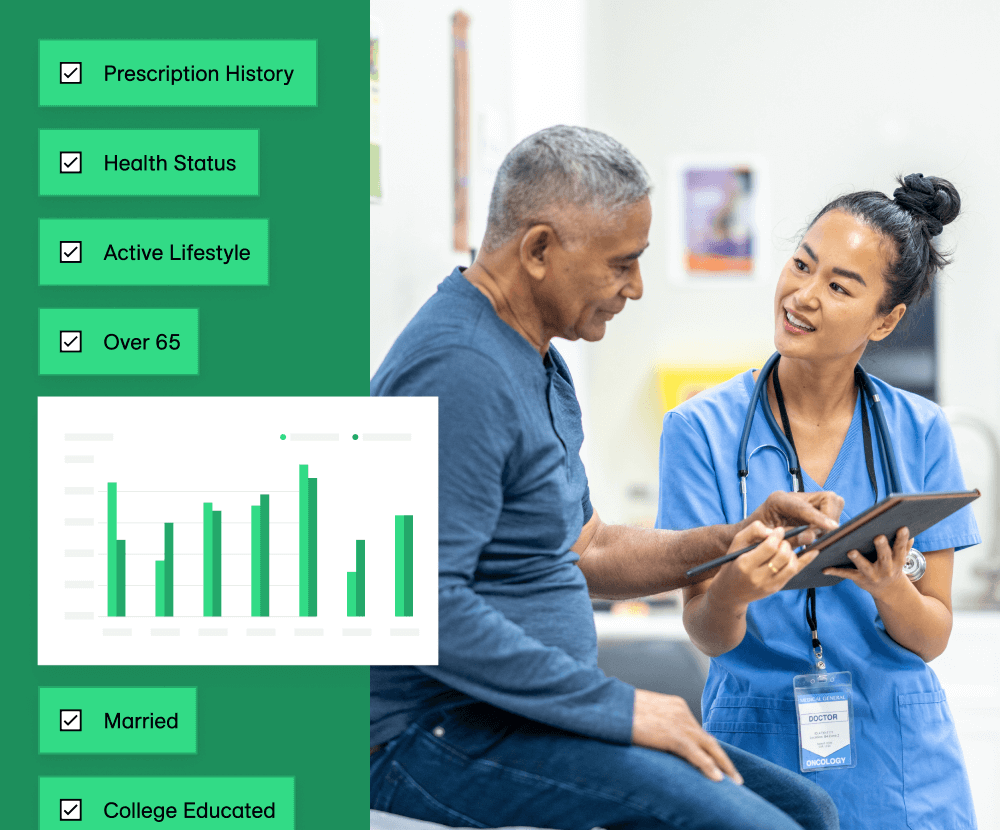How Healthcare and Pharma Marketers Can Reach More Patients in 2025

Pharmaceutical and healthcare marketing is essential for patient care – and it’s anything but easy. Healthcare marketers must face heightened regulatory processes while driving business growth and proving marketing value. And that falls second to arming patients with the information they need to consider new, life-changing treatment options with their provider. On top of ecosystem challenges, patient decision-making is often swayed by factors that are outside of a marketer’s control, including:
- Patient affordance: How a patient interacts with the healthcare environment based on what they feel capable of, given their skills, resources, and confidence. This perception shapes their ability to take action and make informed healthcare decisions.
- Treatment efficacy: The patient’s belief in how well a treatment or prevention method will work for their health condition, whether it's a disease, chronic illness, or other medical issue.
- Patient agency: A patient’s ability to take control of their health by making informed decisions that influence their care, including their ability to take actions to improve their well-being.
Despite these challenges, 65% of healthcare executives are prioritizing growth strategies in 2025, and almost half are focused on affordability for patients. One way the industry is focused on improving treatments and business growth is through person-centered care.
What is person-centered care?
Person-centered care (PCC) extends beyond the traditional, disease-focused healthcare model where symptoms are treated individually, instead, diagnosing and treating a person as a whole. The person-centric approach provides both the patient and provider with a more holistic view of the condition that needs treatment. As a result, PCC has transformed health and wellness beyond illnesses to overall patient well-being – and has opened the doors for greater personalization.
Why personalization is critical for person-centered care: A real-world use case
A leading global pharma manufacturer partnered with LiveRamp to transform patient outreach, shifting from generic third-party data to highly customized audience segments. Using LiveRamp’s platform, they integrated website traffic, ad exposure logs, demographic data, to create a 360-degree audience view and used that to have a more targeted activation strategy. This tailored approach boosted effectiveness by 300x across media channels, proving that taking control over data assets drives superior results. However, siloed marketing strategies remain a challenge in healthcare, limiting collaboration. A person-based marketing approach, powered by responsible data collaboration and identity solutions, is essential for truly patient-centric care.
Challenges to person-based marketing for health and wellness companies
Key challenges facing pharmaceutical and healthcare marketers include underutilized technology investments and misalignment on customer engagement across organizations, according to ZS analysts. They pointed out, “there’s a missing link preventing companies from realizing gains from their omnichannel efforts: the capability for customer engagement strategy and planning.”According to this research, a core challenge for healthcare marketers is a lack of accountability for a unified customer strategy between internal teams – “the customer belongs to no one and everyone.” To overcome this, the researchers suggest a customer strategy owner who is accountable for building the strategy, a clear process, and choosing tools that can deliver personalization at scale. One essential tool for responsible, safe, and personalized customer outreach is identity resolution. Through identity resolution, organizations can connect data across disparate channels while helping to preserve patient privacy and mitigating the impacts of signal loss.
How identity resolution solves person-based marketing challenges
One way to solve for gaps in customer strategy is with a person-based identity that effectively connects disparate data sets across teams while creating a consistent customer view. A trustworthy, deterministic identifier is critical for responsible healthcare marketing, as well as providing person-centered care – from awareness to the first treatment to prescription refills and follow ups. Knowing who your patient is, their health status, prescription history, and other psycho- or socio-graphic dimensions will allow you to reach them with the right messages at the right time and empower them toward treatment.With LiveRamp’s connectivity solutions, healthcare and pharma organizations can align their teams and technology for better business outcomes. Through seamless audience planning and segmentation, activation, and measurement, teams can work together to provide better patient experiences while still meeting individual goals.
Conclusion: High-impact personalization is critical in healthcare
In a complex ecosystem, getting the best treatments to patients requires deep personalization, tailored engagement, and an optimized media mix – areas LiveRamp excels in, driven by decades of expertise in trustworthy data collaboration. LiveRamp’s identity and connectivity solutions unlock superior match rates and insights across channels, fostering better customer engagement, improved health outcomes, and greater patient efficacy and autonomy. For marketers in healthcare and pharmaceuticals, this not only leads to measurable impact across the patient lifecycle, but to higher standards for prescriptions, treatments, and patient care.If you’re ready to fuel personalized patient experiences, talk with an expert.

